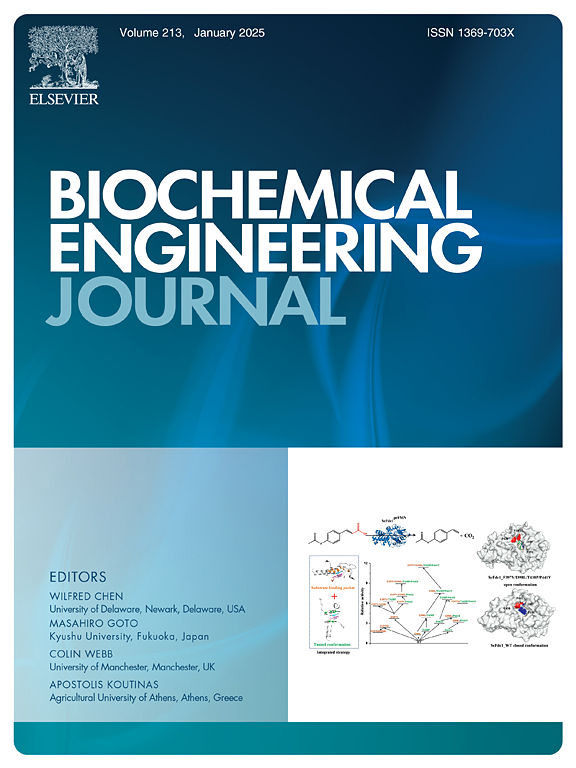Valorization of effluents from the wine industry through a biorefinery scheme to obtain sustainable aviation fuel, levulinic acid, water, and value-added compounds
IF 3.7
3区 生物学
Q2 BIOTECHNOLOGY & APPLIED MICROBIOLOGY
引用次数: 0
Abstract
The wine industry generates a substantial amount of highly polluting wastewater, for which inadequate disposal has become a primary social and environmental concern. At the same time, these effluents are characterized by having a high content of carbohydrates, alcohols, and solids; these compounds can be used to generate bioenergy, a priority axis in México. Thus, this research proposes valorizing wine effluents through a biorefinery to produce biofuels and valuable products, focusing on levulinic acid and sustainable aviation fuel. It also analyzes the economic and environmental impact of the utilities involved. As a methodology, the composition and pretreatment of the wastewater are determined, and the products of interest in the biorefinery are selected. The respective production processes for each product are designed, simulated, and integrated into Aspen Plus V14; after that, a parametric analysis of the manipulated variables is carried out, and the removal of the organic load is evaluated based on the Chemical Oxygen Demand (COD) as an indicator, which is compared with that indicated by the NOM-001-SEMARNAT-2021 standard. As a result, levulinic acid, sustainable aviation fuel, green diesel, naphtha, light gases, glycols, bioethanol, and electrical power are produced. At the same time, an attractive profit ($245,513,069.86 USD) is also realized. In addition, the biorefinery reduces the COD of the effluent by 99.99 %.
通过生物精炼方案对葡萄酒工业的废水进行增值处理,以获得可持续的航空燃料、乙酰丙酸、水和增值化合物
葡萄酒行业产生大量高污染废水,处理不当已成为一个主要的社会和环境问题。同时,这些废水的特点是具有高含量的碳水化合物、醇和固体;这些化合物可以用来产生生物能源,这是msamxico的一个优先轴。因此,本研究建议通过生物精炼厂对葡萄酒废水进行估价,以生产生物燃料和有价值的产品,重点是乙酰丙酸和可持续航空燃料。它还分析了所涉及的公用事业的经济和环境影响。作为一种方法,确定了废水的组成和预处理,并选择了生物炼制中感兴趣的产品。每个产品的各自生产过程都经过设计、模拟并集成到Aspen Plus V14中;之后,对操纵变量进行参数化分析,以化学需氧量(COD)为指标评价有机负荷去除效果,并与NOM-001-SEMARNAT-2021标准进行比较。因此,可以生产乙酰丙酸、可持续航空燃料、绿色柴油、石脑油、轻质气体、乙二醇、生物乙醇和电力。同时,也实现了可观的利润($245,513,069.86 USD)。此外,生物精馏使出水COD降低99.99 %。
本文章由计算机程序翻译,如有差异,请以英文原文为准。
求助全文
约1分钟内获得全文
求助全文
来源期刊

Biochemical Engineering Journal
工程技术-工程:化工
CiteScore
7.10
自引率
5.10%
发文量
380
审稿时长
34 days
期刊介绍:
The Biochemical Engineering Journal aims to promote progress in the crucial chemical engineering aspects of the development of biological processes associated with everything from raw materials preparation to product recovery relevant to industries as diverse as medical/healthcare, industrial biotechnology, and environmental biotechnology.
The Journal welcomes full length original research papers, short communications, and review papers* in the following research fields:
Biocatalysis (enzyme or microbial) and biotransformations, including immobilized biocatalyst preparation and kinetics
Biosensors and Biodevices including biofabrication and novel fuel cell development
Bioseparations including scale-up and protein refolding/renaturation
Environmental Bioengineering including bioconversion, bioremediation, and microbial fuel cells
Bioreactor Systems including characterization, optimization and scale-up
Bioresources and Biorefinery Engineering including biomass conversion, biofuels, bioenergy, and optimization
Industrial Biotechnology including specialty chemicals, platform chemicals and neutraceuticals
Biomaterials and Tissue Engineering including bioartificial organs, cell encapsulation, and controlled release
Cell Culture Engineering (plant, animal or insect cells) including viral vectors, monoclonal antibodies, recombinant proteins, vaccines, and secondary metabolites
Cell Therapies and Stem Cells including pluripotent, mesenchymal and hematopoietic stem cells; immunotherapies; tissue-specific differentiation; and cryopreservation
Metabolic Engineering, Systems and Synthetic Biology including OMICS, bioinformatics, in silico biology, and metabolic flux analysis
Protein Engineering including enzyme engineering and directed evolution.
 求助内容:
求助内容: 应助结果提醒方式:
应助结果提醒方式:


